|
Visiting
Mendoza, Argentina
Part 5: Terrazas de los Andes
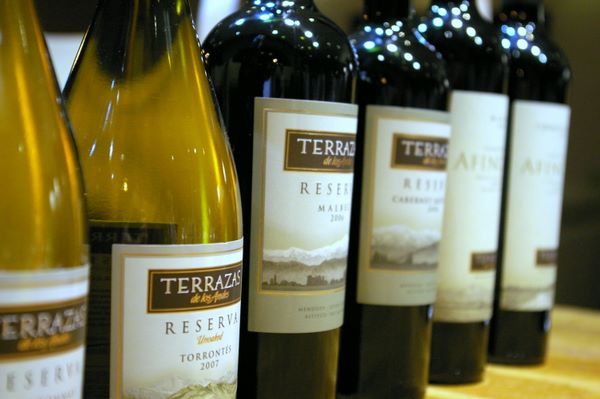
Terrazas was the next appointment. Some disclosure is
needed here, because they were the company responsible for funding
this trip, and we were staying in the very pleasant guest house at
the winery. However, they generously agreed to allow us to visit
other producers of our choosing on the trip, which made accepting
the invitation a lot easier.
We began the day by meeting with general manager Carlos
Riquelme (below), who shares his name with a famous
footballer. The vineyard we visited was in Las Compuertas; also near
here is another important vineyard area for Terrazas, Vistalba.
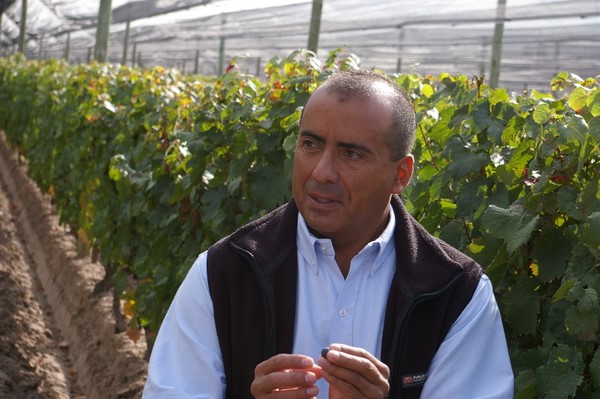
At Las Compuertas, Terrazas have a sizeable 60 hectares
of old-vine Malbec. Itís a region where housing is encroaching on
vineyard land, so this is one of the biggest blocks. Because of
housing pressure, vineyards here are worth US$100 K per hectare,
which is expensive for Mendoza.
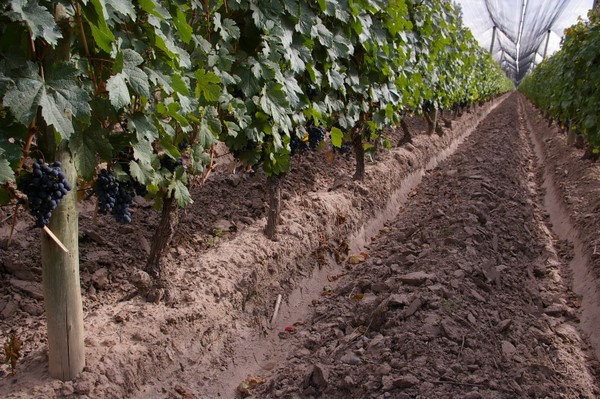
Vines were planted here in 1930, and the vineyard was
bought by Chandon in 1980. Initially, Chandonís policy was to
change Malbec to Pinot Noir, because this is what they needed for
their sparkling wine. But in the 1990s they began to shift their
focus towards still wines and are now grafting 15 year old Pinot
back to Malbec. Fortunately, much of the old vine Malbec survived
this transition.
Altitude here is 1070 m, with lower average
temperatures than usual for Mendoza. The thermal amplitude is
significant: 15 įC difference between day and night means that
ripening happens slowly and the aroma, colour and flavour are very
good.
Mendoza is around 200 miles from Santiago (Chile), with
the Andes in the way. The Andes act as a fantastic barrier blocking
the pacific influence which is so important for the Chilean wine
regions. Here, the vineyards are 800 miles from the Atlantic on the
other side, so Mendoza is one of the few significant vineyard areas
in the world where there is very limited maritime influence.
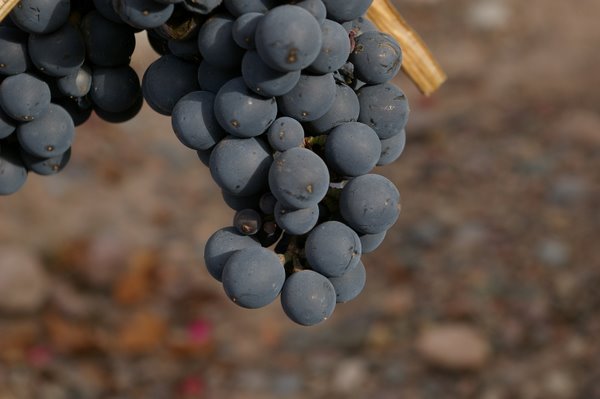
Here, altitude is all important, and Terrazasí policy
is to try to plant the right variety at the right elevation. They go
up to 1500 m for sparkling base wines, 1200 m is just right for
Chardonnay, 1100 m is perfect for Malbec (e.g. here and Vistalba),
and then 980 m suits Cabernet Sauvignon.
The soil also matters: itís a mix between sand and
clay here, so the soil retains enough moisture from periodic
irrigation for the shoots to grow without becoming excessively
vigorous. Irrigation here, as with most other Mendoza vineyards, is
by flood through a system of channels. In the past, the vines might
have been watered whenever water was available, resulting in high
yields (20 tons/hectare) and low quality. Now it is just once or
twice a year.
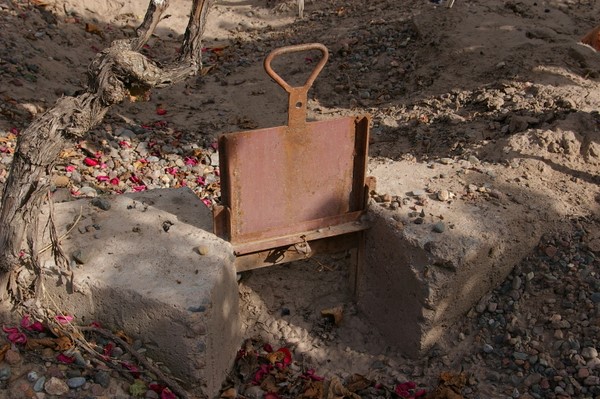
The Malbec vine stock used here came from France around
1850, prior to phylloxera. No clones are used; all the plants are a
bit different, and this mix of characteristics is thought to add
complexity to the wines. The modern French clones are more
productive with bigger berries and lower quality compared with the
old vine material.
New vines here are produced by the old technique of
layering, where a shoot is buried and in turn forms a new root
system. This can only work where the vines are ungrafted, as they
are here. Disease pressure is low, with no insect pests.
Consequently, just copper sulphate and sulphur are used to combat
fungal diseases. Glyphosate (herbicide) is used in the rows just
under the vines, and every five years or so the nutrient levels in
the vines are monitored and fertilizer is applied if needed. The
vine roots go down 2 metres, so usually very little is required.
The vineyards here give more of a red fruit quality to
Malbec; in Valle díUco you get more floral, violet aromatics. The
fruit from this vineyard usually goes to Afincado (yield for this
will be 5000 kg/hectare) or the Reserva.
According to Manuel Louzada (below), who heads
up Terrazas, pruning is the key to quality in Mendoza. To achieve
the right balance, they leave one fruit cluster per shoot for
Afincado, 1.5 for Reserva and 2 clusters per shoot for the entry
level wines. Vineyard labour is still cheap here.
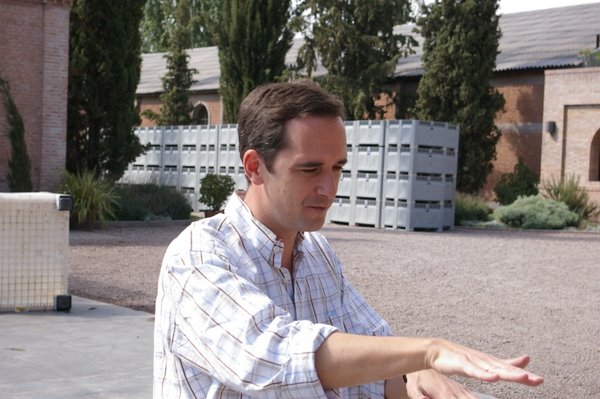
After the vineyard visit, we toured the main Terrazas
winery. Itís one of the three Mendoza wineries Terrazas own, and
is currently in the process of renovation. 7000 tons of fruit are
processed each vintage here. The vineyards are run so that they get
about double the Afincado/Cheval des Andes quality grapes, 40% more
of Reserva quality and 20% more of the varietal level wines. This
allows for selection in the winery to achieve the required quality.
The winery was originally built in 1898 by Sorteiro
Arizu, who owned around 4000 hectares of vines here. This was one of
the big winemaking families at the time. At the end of the 1920s a
new winery was built by new owners Domecq: a tall building to
accommodate the Ďgiraffeí distillation columns for making brandy
(below).
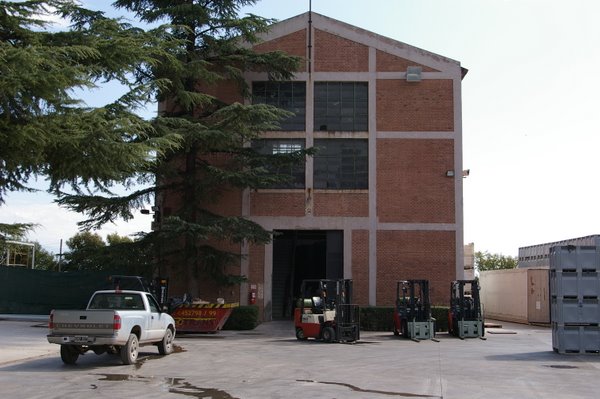
The modern history of the winery begins in the 1950s,
with Robert van de VogŁe, the then president of MoŽt who began to
see that the production of Champagne wouldnít be enough for the
whole world. He embarked on a global search for places to make
sparkling wine. From 1955Ė9 he sent his most recognized Champagne
winemaker to several countries, including Argentina, Brazil and
Chile. It was Argentina that caught his eye, and he decided to form
the first MoŽt subsidiary in Argentina.
The trials were conducted in this winery because of the
links that existed between Domecq and MoŽt. The winery stayed in
the Domecq family until the 1970s when Domecq first rented it to
MoŽt-Hennessy and then sold it to them in the 1980s, when it was
used as a cellar.
MoŽt-Hennessy began their still wine program in 1991
and started to do trials, making the first Terrazas wines in 1997.
They began to rebuild this winery in 1998.
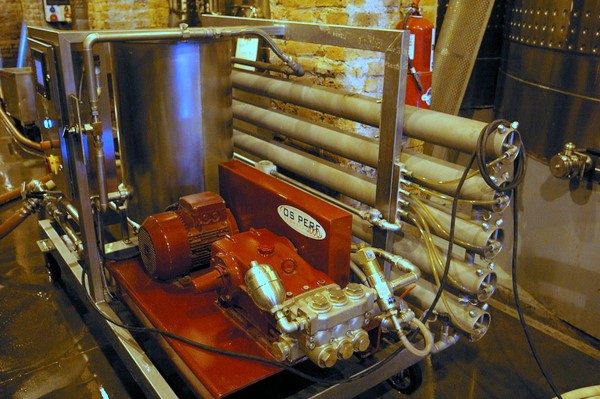
Reverse
osmosis machine in the winery
Terrazas Reserva Chardonnay 2007 Tupungato, Mendoza
Rich, ripe, toasty nose with smooth fruit. Quite tropical, but
also has a smooth freshness, finishing with some citrussy notes. A
nice mix of tropical fruit and freshness. 88/100
Terrazas Reserva Torrontes 2007
Torrontes is a terpenic grape (terpenes are a class of flavour
compound also found in Muscat and Gewurztraminer). There are two
sides to terpenes: they can lose elegance and show tinned peach
character, or they can go more floral with orange blossom and rose
petal notes. This is aromatic, fresh and floral with orange blossom
and some tangerine notes. Soft textured palate with nice freshness
and bright fruit. 88/100
Terrazas Reserva Malbec 2006
Very attractive sweet cherryish nose with some meaty, ripe black
fruits. The palate is fresh with nice sweetness, as well as nice
grippy tannins. Sweet fruit combines well with good acid and grip: a
stylish fruit-driven wine. 89/100
Terrazas Reserva Cabernet Sauvignon 2006
Dense, sweet, structured wine with bold fruit and good tannins.
Thereís nice mid-palate richness here. I like the dense, ripe,
structured blackcurrant and berry fruit, with some spiciness in the
background. 89/100
Afincado Malbec 2005
Sweet, dense, ripe and meaty on the nose, which is lush but
still well defined. The palate is dense and concentrated with lovely
smooth tannins. Ripe, concentrated, meaty and more-ish.
Fruit-dominated with a lovely round mouthfeel, as well as some
elegance. 93/100
Afincado Cabernet Sauvignon 2005
Dense and pure with smooth fruit and firm tannins. Lovely
blackcurrant fruit with real purity and great intensity. Thereís
good structure and density, and this should age well. 93/100
Wines tasted 03/08
Find these wines with wine-searcher.com
Back
to top
|

